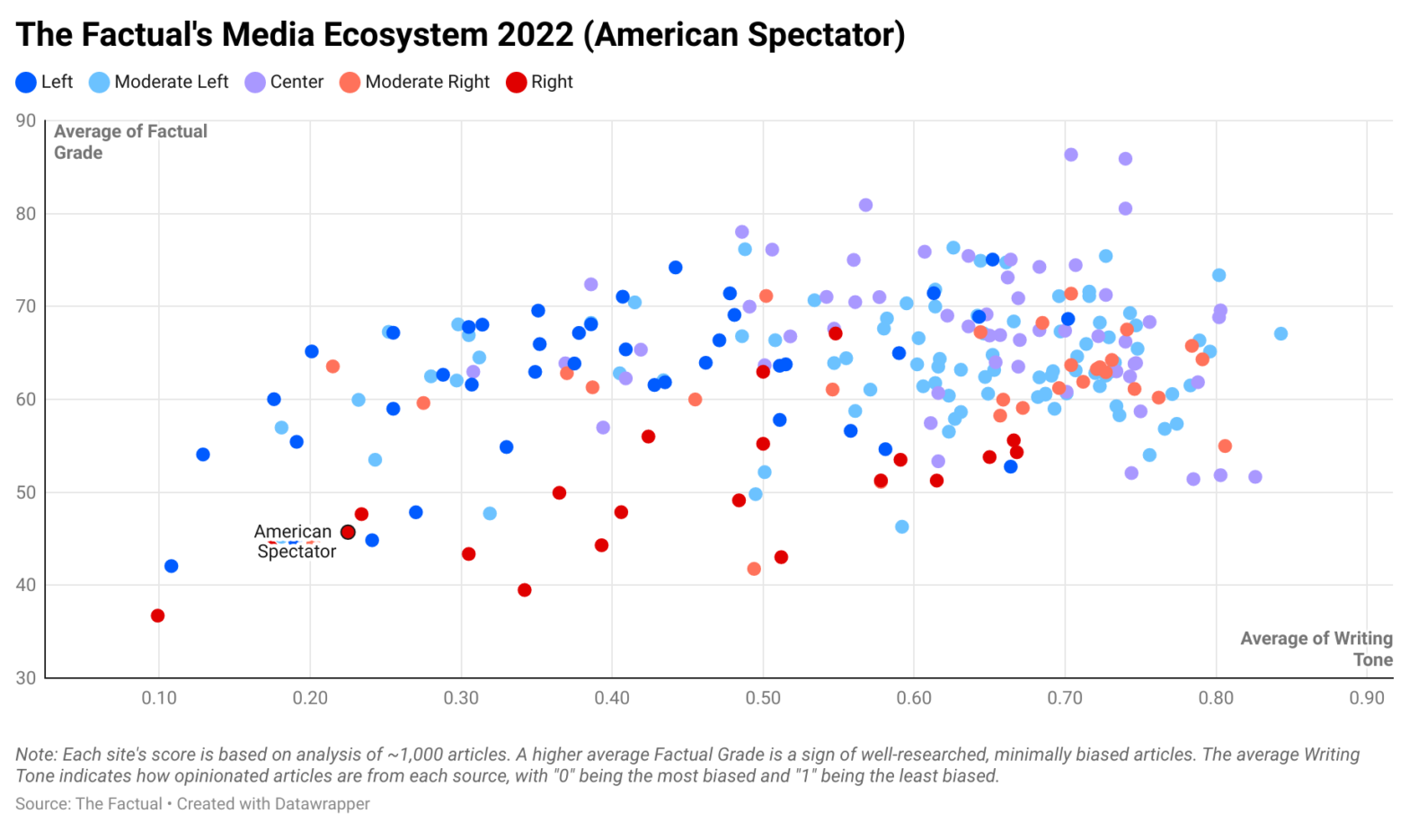The American Spectator is a conservative magazine and website that grew in prominence in the 1990s publishing “political scandal” articles related to figures such as former President Bill Clinton and Clarence Thomas accuser Anita Hill. Internal strife, including debates about financial transparency, saw the magazine nearly collapse before being rebuilt over the 2000s and 2010s. Today, the publication hosts conservative thinkers, respected and controversial alike, but is also the subject of considerable scrutiny. So, how reliable are news articles from the American Spectator?
How Does The Factual Rate News Sources?
The Factual analyzes more than 10,000 news stories every day to help readers find the most informative, least-biased articles. Our news-rating algorithm scores each article along four metrics: (1) cited sources and quotes, (2) publication history, (3) writing tone, and (4) author expertise. These scores combine in a weighted average we call a Factual Grade, which ranges from 0–100%. (See our How It Works page to learn more about our algorithm.)
For this study, we analyzed ~1,000 articles each from 240 news sources. The average Factual Grade for the entire dataset was 62.5%. Based on these averages, we can compare the performance of news sites across the media ecosystem. The entire dataset can be explored in greater detail here.
How Factual Is the American Spectator?
The American Spectator scored an average Factual Grade of 45.7%, placing it in the 6th percentile of our dataset. Several factors contribute to these very low scores. Articles from the American Spectator often fail to incorporate ample links to external sources to support their articles, or only link to a very limited range of sources. Author expertise scores for the site are generally low, which suggests that contributors do not regularly write for the site, do not cover the same topics consistently, or routinely write articles that have scored poorly according to The Factual. Finally, articles tend to be highly opinionated, suggesting they intend to elicit an emotional response rather than neutrally convey information.
Like any news source, scores for articles from the American Spectator varied widely based on factors like author expertise and cited evidence. For example, some scored above 80%, while many others scored below 50%.
Please check your email for instructions to ensure that the newsletter arrives in your inbox tomorrow.
How Opinionated Is the American Spectator?
One of the metrics The Factual uses is the Writing Tone, which measures how opinionated the writing is in an article. For this metric, the algorithm looks for signs of subjective commentary (e.g., first person pronouns and unnecessary adverbs), as well as the emotional nature of selected words, and sees how prevalent they are for a given length of text. More neutral text receives higher ratings, with “0” being the most opinionated and “1” being the most neutral.
The American Spectator had an average Writing Tone score of 0.23, placing it in the 5th percentile in our dataset. This indicates that articles from the site use highly opinionated language, including emotionally loaded wording and headlines. Examples of such headlines include: “Remember, the Bidens Are Trash” and “Mass Murder by Mail.”
What Is the American Spectator’s Political Bias?
The Factual classifies news sites by political bias as either Left, Moderate Left, Center, Moderate Right, or Right. This classification is derived from third-party assessments from media bias organizations such as AllSides and Media Bias/Fact Check. Based on this data, The Factual assigns the American Spectator a “Right” bias.
AllSides classifies the American Spectator as “Right” due to independent research and 16,699 community ratings. AllSides does not offer additional detail to explain this rating, perhaps because the classification is uncontroversial. For example, the site’s “About” page says that it favors “traditional American values, such as economic freedom, individual liberty, self-sufficiency, and limited government” and serves as “an outlet for a host of both young and established conservative writers and thinkers.”
Media Bias/Fact Check (MBFC) also rates the American Spectator as “Right,” noting “story selection and editorial positions that consistently favor the right.” Furthermore, they warn about the site’s reputation for failed fact checks, poor sourcing of information, and lack of transparency regarding its funding. MBFC notes that the site very rarely supplies any sources with its articles and that “story selection always favors the right and denigrates the left.” MBFC also warns that the American Spectator regularly publishes articles that strongly contradict the scientific consensus on climate change.
Please check your email for instructions to ensure that the newsletter arrives in your inbox tomorrow.
Who Owns the American Spectator?
The American Spectator is owned by the nonprofit American Spectator Foundation. Though the publication is partially supported through advertising, subscriptions, and donations, the foundation is not transparent about its funding.
Why Does It Matter?
News articles always have some bias because all authors have some frame of reference within which they describe a story. Political bias ratings are helpful in understanding this framing. However, it can be more beneficial to know how factual an article is based on quantifiable metrics that can be seen across the media ecosystem, such as cited evidence, author expertise, and writing tone. This is what The Factual ascertains.
Reading several, highly rated articles from across the political spectrum helps counter the bias of any news source or story. To have the day’s most factual news stories delivered to your inbox every morning, subscribe to our daily newsletter.
This article was updated on September 15, 2022 to reflect new data.

